The Cambridge History of China. Vol. 13: Republican China 1912-1949, Part 2
Подождите немного. Документ загружается.

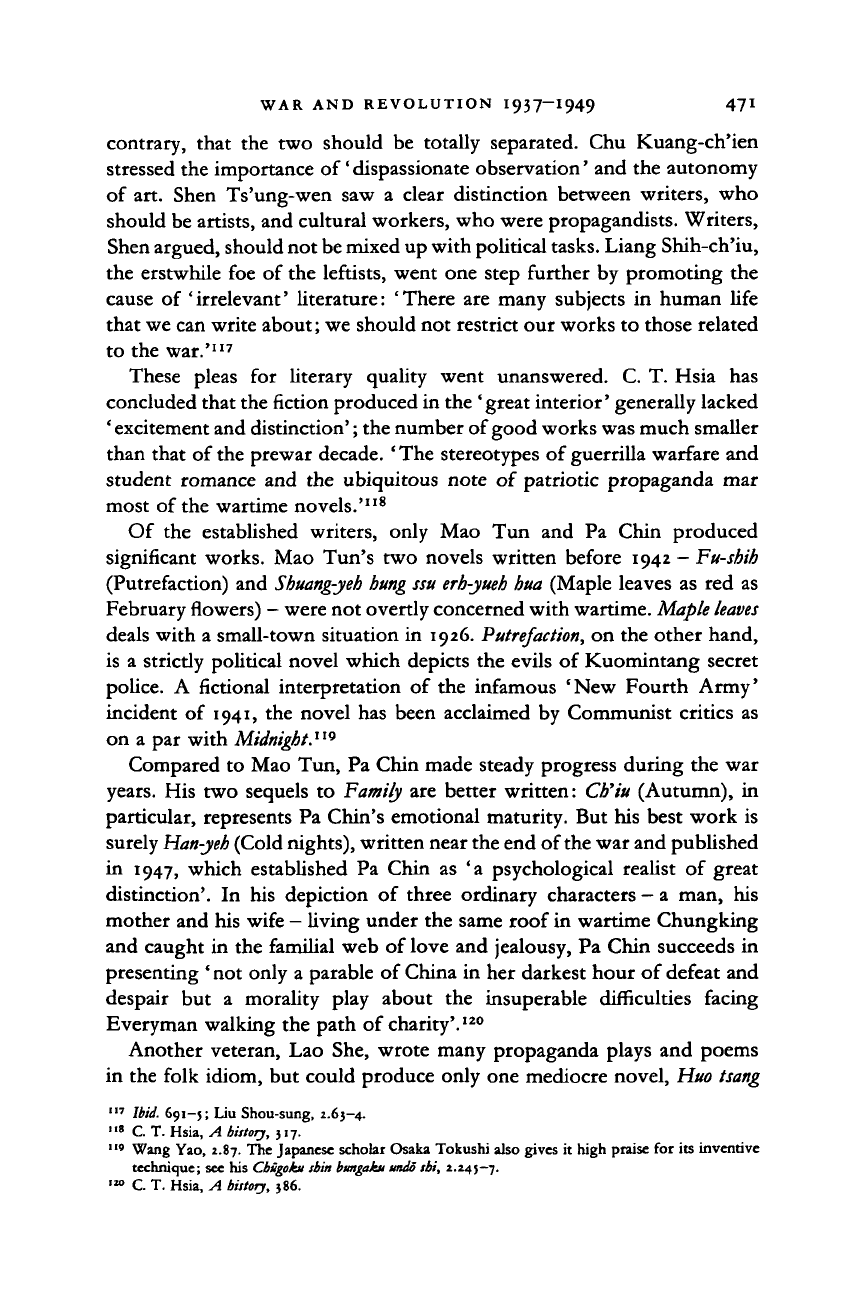
WAR AND REVOLUTION I937-I949 471
contrary, that
the
two should
be
totally separated.
Chu
Kuang-ch'ien
stressed the importance of' dispassionate observation' and the autonomy
of art. Shen Ts'ung-wen saw
a
clear distinction between writers,
who
should be artists, and cultural workers, who were propagandists. Writers,
Shen argued, should not be mixed up with political
tasks.
Liang Shih-ch'iu,
the erstwhile foe
of
the leftists, went one step further by promoting the
cause
of
'irrelevant' literature: 'There are many subjects
in
human life
that we can write about; we should not restrict our works to those related
to the war.'
117
These pleas
for
literary quality went unanswered. C. T. Hsia
has
concluded that the fiction produced in the' great interior' generally lacked
' excitement and distinction'; the number of good works was much smaller
than that of the prewar decade. ' The stereotypes of guerrilla warfare and
student romance and the ubiquitous note
of
patriotic propaganda mar
most of the wartime novels.'"
8
Of the established writers, only Mao
Tun and Pa
Chin produced
significant works. Mao Tun's two novels written before 1942
-
Fu-shih
(Putrefaction) and
Shuang-yeh hung ssu erh-yueh hua
(Maple leaves as red
as
February flowers)
-
were not overtly concerned with wartime.
Maple leaves
deals with a small-town situation in 1926.
Putrefaction,
on the other hand,
is
a
strictly political novel which depicts the evils
of
Kuomintang secret
police.
A
fictional interpretation
of
the infamous 'New Fourth Army'
incident
of
1941, the novel has been acclaimed by Communist critics
as
on
a
par with Midnight.
119
Compared to Mao Tun, Pa Chin made steady progress during the war
years.
His two sequels
to
Family are better written: Ch'iu (Autumn),
in
particular, represents Pa Chin's emotional maturity. But his best work
is
surely
Han-jeh
(Cold nights), written near the end of the war and published
in 1947, which established
Pa
Chin
as 'a
psychological realist
of
great
distinction'.
In his
depiction
of
three ordinary characters
-
a man,
his
mother and his wife
-
living under the same roof in wartime Chungking
and caught in the familial web of love and jealousy, Pa Chin succeeds in
presenting ' not only a parable of China in her darkest hour of defeat and
despair
but a
morality play about
the
insuperable difficulties facing
Everyman walking the path of charity'.
120
Another veteran, Lao She, wrote many propaganda plays and poems
in the folk idiom, but could produce only one mediocre novel, Huo
tsang
117
Ibid.
691—5; Liu Shou-sung, 2.63—4.
"» C.
T.
Hsia,
A
history, 317.
"• Wang Yao, 2.87. The Japanese scholar Osaka Tokushi also gives
it
high praise for its inventive
technique; see his Cbugohi shin
bungaksi undo
sbi, 2.245—7-
120
C.
T.
Hsia,
A
history, 386.
Cambridge Histories Online © Cambridge University Press, 2008
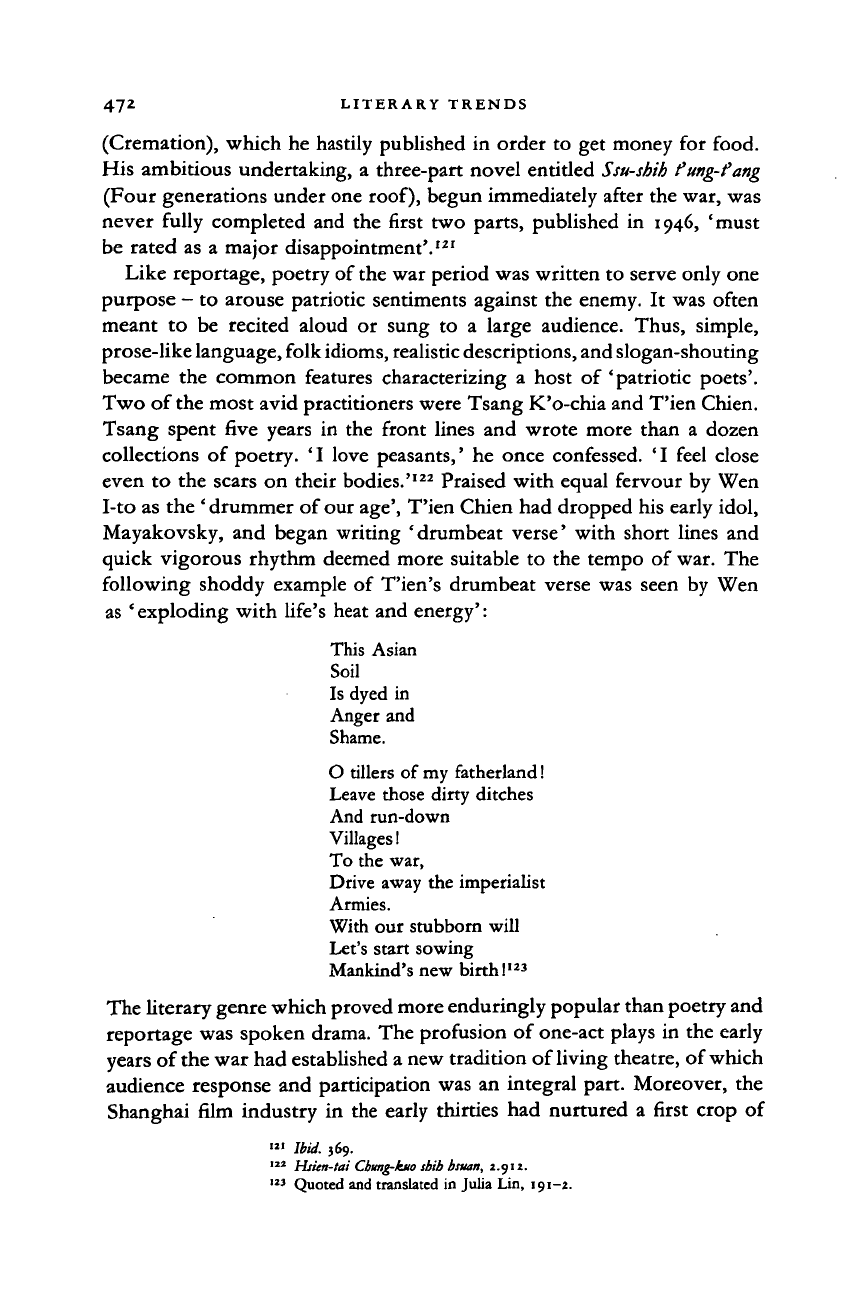
47
2
LITERARY TRENDS
(Cremation), which
he
hastily published
in
order
to get
money
for
food.
His ambitious undertaking,
a
three-part novel entitled
Ssu-shih
fung-fang
(Four generations under one roof), begun immediately after the war, was
never fully completed
and the
first
two
parts, published
in
1946, 'must
be rated
as a
major disappointment'.
121
Like reportage, poetry
of
the war period was written
to
serve only one
purpose
- to
arouse patriotic sentiments against
the
enemy.
It
was often
meant
to be
recited aloud
or
sung
to a
large audience. Thus, simple,
prose-like language, folk
idioms,
realistic descriptions, and slogan-shouting
became
the
common features characterizing
a
host
of
'patriotic poets'.
Two
of
the most avid practitioners were Tsang K'o-chia and T'ien Chien.
Tsang spent five years
in the
front lines
and
wrote more than
a
dozen
collections
of
poetry. ' I love peasants,'
he
once confessed. ' I feel close
even
to the
scars
on
their bodies.'
122
Praised with equal fervour
by
Wen
I-to
as the '
drummer
of
our age', T'ien Chien had dropped his early idol,
Mayakovsky,
and
began writing 'drumbeat verse' with short lines
and
quick vigorous rhythm deemed more suitable
to the
tempo
of
war.
The
following shoddy example
of
T'ien's drumbeat verse
was
seen
by Wen
as
'
exploding with life's heat
and
energy':
This Asian
Soil
Is dyed
in
Anger and
Shame.
O tillers
of
my fatherland!
Leave those dirty ditches
And run-down
Villages!
To the war,
Drive away the imperialist
Armies.
With our stubborn will
Let's start sowing
Mankind's new birth!
123
The literary genre which proved more enduringly popular than poetry and
reportage was spoken drama. The profusion
of
one-act plays
in the
early
years
of
the war had established a new tradition
of
living theatre, of which
audience response
and
participation was
an
integral part. Moreover,
the
Shanghai film industry
in the
early thirties
had
nurtured
a
first crop
of
121
Ibid.
369.
122
Hsien-tai Cbung-kuo sbib btuan, 2.912.
123
Quoted and translated
in
Julia Lin, 191-2.
Cambridge Histories Online © Cambridge University Press, 2008
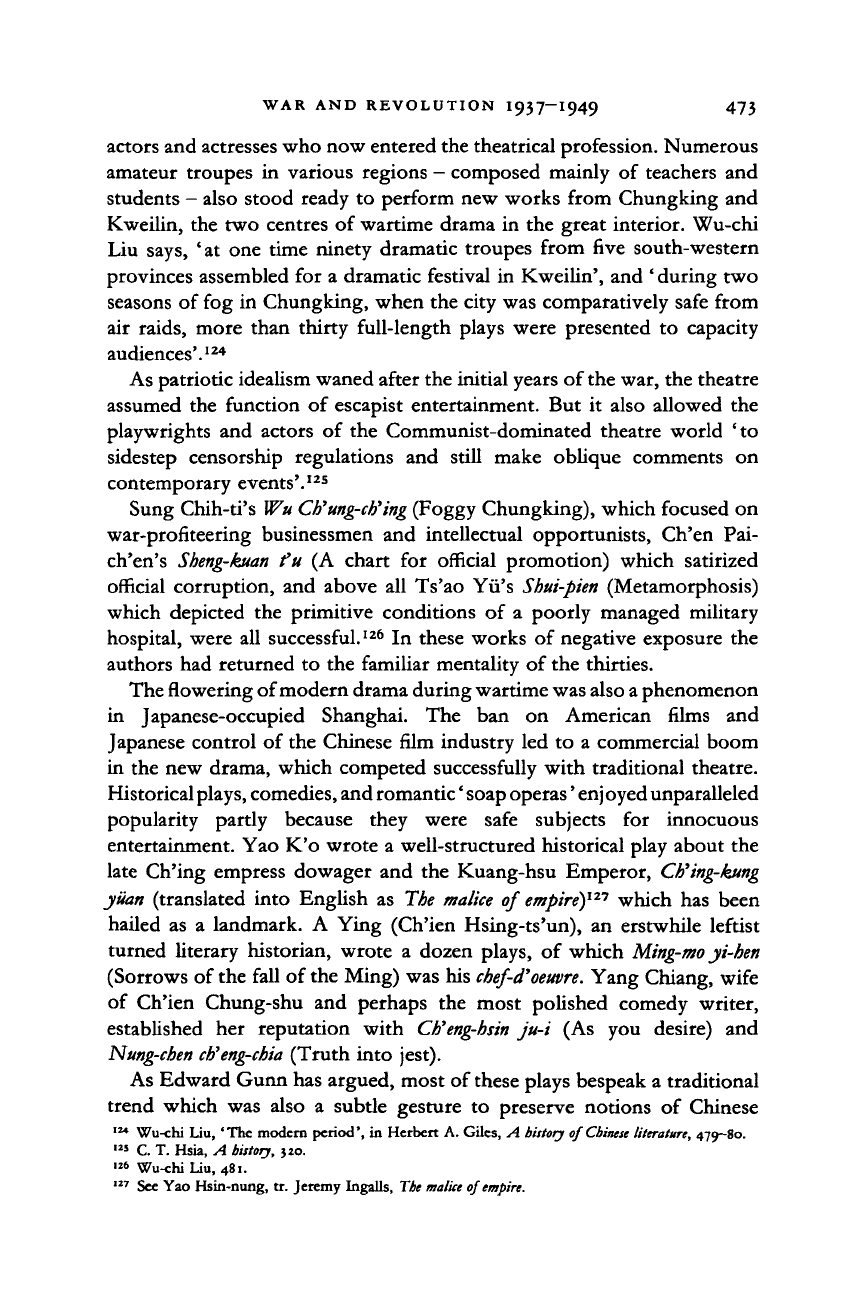
WAR AND REVOLUTION 1937-1949 473
actors and actresses who now entered the theatrical profession. Numerous
amateur troupes in various regions - composed mainly of teachers and
students - also stood ready to perform new works from Chungking and
Kweilin, the two centres of wartime drama in the great interior. Wu-chi
Liu says, 'at one time ninety dramatic troupes from five south-western
provinces assembled for a dramatic festival in Kweilin', and 'during two
seasons of fog in Chungking, when the city was comparatively safe from
air raids, more than thirty full-length plays were presented to capacity
audiences'.
124
As patriotic idealism waned after the initial years of the war, the theatre
assumed the function of escapist entertainment. But it also allowed the
playwrights and actors of the Communist-dominated theatre world 'to
sidestep censorship regulations and still make oblique comments on
contemporary events'.
125
Sung Chih-ti's Wu
Ch'ung-ch'ing
(Foggy Chungking), which focused on
war-profiteering businessmen and intellectual opportunists, Ch'en Pai-
ch'en's
Sheng-kuan
fu (A chart for official promotion) which satirized
official corruption, and above all Ts'ao Yii's
Shui-pien
(Metamorphosis)
which depicted the primitive conditions of a poorly managed military
hospital, were all successful.
126
In these works of negative exposure the
authors had returned to the familiar mentality of the thirties.
The flowering of modern drama during wartime was also
a
phenomenon
in Japanese-occupied Shanghai. The ban on American films and
Japanese control of the Chinese film industry led to a commercial boom
in the new drama, which competed successfully with traditional theatre.
Historical
plays,
comedies, and romantic' soap operas' enjoyed unparalleled
popularity partly because they were safe subjects for innocuous
entertainment. Yao K'o wrote a well-structured historical play about the
late Ch'ing empress dowager and the Kuang-hsu Emperor,
Ch'ing-kung
yuan (translated into English as The
malice
of
empire)
121
which has been
hailed as a landmark. A Ying (Ch'ien Hsing-ts'un), an erstwhile leftist
turned literary historian, wrote a dozen plays, of which
Ming-mo yi-hen
(Sorrows of the fall of the Ming) was his
chef-d'oeuvre.
Yang Chiang, wife
of Ch'ien Chung-shu and perhaps the most polished comedy writer,
established her reputation with
Ch'eng-hsin
ju-i (As you desire) and
Nung-cben
ch'eng-chia
(Truth into jest).
As Edward Gunn has argued, most of these plays bespeak a traditional
trend which was also a subtle gesture to preserve notions of Chinese
124
Wu-chi Liu, "The modern period',
in
Herbert A. Giles,
A
history
of
Chinese literature, 479-80.
125
C. T. Hsia,
A
history, jzo.
126
Wu-chi Liu, 481.
127
See Yao Hsin-nung, tr. Jeremy Ingalls,
Tie
malice of empire.
Cambridge Histories Online © Cambridge University Press, 2008

474 LITERARY TRENDS
culture against Japanese domination.
128
Chou Tso-jen, living
in
Peking
in the style
of
a traditional recluse, suggested subtly
in
his essays that
it
was still the Chinese people, and not their Japanese rulers, who could best
appreciate the humanity
of
their own tradition. Chang Ai-ling (Eileen
Chang), whom C. T. Hsia regards as modern China's finest writer, used
the family system as
a
central focus
in
stories like 'The golden cangue'
to explore the impact of tradition on the modern psyche.
129
And finally,
Ch'ien Chung-shu,
in
Wei-ch'eng
(Fortress besieged),
in a
picaresque
fashion dissected with learned wit and scathing satire a host of characters
that 'in absurd postures of vanity and fraud' show an intelligentsia failing
to grasp the essence of both traditional and modern cultures.
130
Thus some
of the finest works of both drama and fiction were created in 'occupied'
China.
Few committed writers in the 1930s foresaw any possible discrepancy
between their creative vision and the socio-political goals they espoused.
During the war period, however, several prominent writers, Lao She in
particular, voluntarily gave up their individual visions
in
their patriotic
zeal to serve their country. The result was an increasing emphasis on the
significance
of
one's audience and
so
drama naturally became the most
powerful literary medium. The issue
of
individual creativity became
a
serious political problem when such
a
vision came to be
at
odds with
a
prescribed collective vision which the individual author also fervently
supported; when the modern Chinese writer could no longer claim,
as
he had done ever since the May Fourth period, that he was endowed with
more sensitivity and compassion toward his fellow countrymen, which
enabled him
to
achieve more profound insight into
his
society.
The
challenge
to
individual creativity
in
this sense never existed in occupied
China, nor was
it
perceived by writers
in
the great interior.
It
was not
until Mao Tse-tung delivered his Talks on Art and Literature
at
Yenan
in 1942 that this challenge was brought forth, with all the intellectual force
and political power
at
Mao's command,
for the
specific purpose
of
rectifying the thinking of the literary intellectuals and altering the very
definition of literature.
128
This information on wartime drama in Japanese-occupied Shanghai is entirely drawn from the
pioneering research
of
Edward Gunn. See his
Unwelcome
muse:
Chinese literature
in
Shanghai and
Peking,
19)7-194], and his research paper,'Chinese writers under Japanese occupation (1937—45)'-
120
The novelette
is
included
in
C. T. Hsia, ed.
Chinese
stories,
138-91,
and
in
Lau, Hsia and Lee,
eds.,
5
3O-59-
"° C. T. Hsia,
A
history,
445.
Cambridge Histories Online © Cambridge University Press, 2008

THE YENAN FORUM 475
THE YENAN FORUM
Mao's convening
of
the famous Yenan Forum on Literature and Art
in
May 1942 was part of the newly initiated rectification campaign directed
at all Communist cadres. Mao's ideological intent
-
to remould the minds
of Yenan intellectuals
-
was evident. But as an intellectual
himself,
Mao
was also interested
in
new literary trends since the May Fourth period.
As his Talks revealed, he was well informed about literary debates in the
early thirties and he may have kept up with some of the creative writings,
particularly the works of Lu Hsun, produced in leftist literary
circles.
Thus
the Yenan Talks can be read as Mao's own reassessment, following the
footsteps
of
Ch'ii Ch'iu-pai,
of
modern Chinese literature from May
Fourth to 1942. But at the same time, Mao was certainly aware of certain
recent issues
on the
literary scene which required clarification
and
solution.
Earlier
in
1938,
in a
speech
at
the CCP sixth plenum, entitled 'The
position
of
the Chinese Communist Party
in
the national struggle', Mao
called upon
his
fellow party members
to
'make Marxism concretely
Chinese', to abolish 'foreign-slanted pedantry and obscurantism', and
to
replace
it
with a ' fresh and vivid Chinese style and manner, of which the
Chinese masses are fond'. Mao concluded by asserting that
'to
separate
international content from national forms is to betray one's ignorance of
internationalism; we must weld the two closely together'.
131
Mao's directive did not specifically touch on literature, but its relevance
to the literary field was soon picked up by the Yenan cultural commissars
-
notably Ch'en Po-ta, Ai Ssu-ch'i and Chou Yang. The ensuing debate on
'national forms' in 1939-40 was extended to Chungking. Articles arising
from the debate were filled with confusing arguments, because
no
one
was exactly clear what Mao meant by ' national forms' and ' international
content'; the heated diatribes therefore were really groping attempts
by
the authors concerned
to
find the true source
of
'national forms'. One
group, represented chiefly
by
Lin Ping, considered 'national forms'
to
be
the
same
as
traditional popular
art
forms enjoyed
by the
people.
Following Ch'ii Ch'iu-pai, they attacked the May Fourth brand
of
new
literature
as
'foreign-slanted pedantry'
and
products
of the
urban
bourgeoisie which must
be
rejected. Writers
in the
opposite camp,
however, rallied
to the
defence
of the 'May
Fourth revolutionary
tradition'
by
maintaining that
the
mainstream
of
the New Literature
represented,
in
fact, the 'national form' or was moving in this direction.
In the words of Hu Feng, its most articulate spokesman, ' national forms
131
Quoted in
ibid.
301-2.
Cambridge Histories Online © Cambridge University Press, 2008
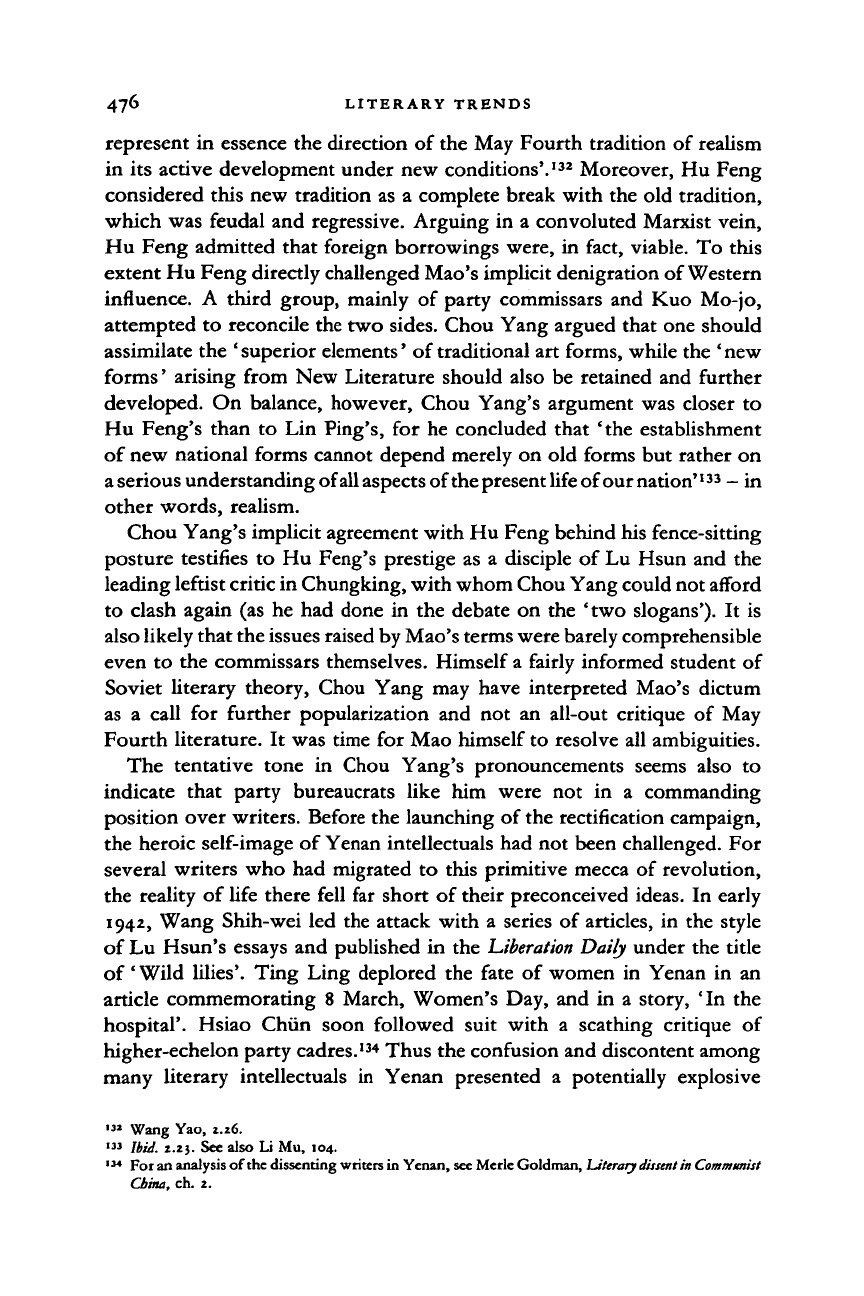
LITERARY TRENDS
represent in essence the direction of the May Fourth tradition of realism
in its active development under new conditions'.
132
Moreover, Hu Feng
considered this new tradition as a complete break with the old tradition,
which was feudal and regressive. Arguing in a convoluted Marxist vein,
Hu Feng admitted that foreign borrowings were, in fact, viable. To this
extent Hu Feng directly challenged Mao's implicit denigration of Western
influence. A third group, mainly of party commissars and Kuo Mo-jo,
attempted to reconcile the two sides. Chou Yang argued that one should
assimilate the ' superior elements' of traditional art forms, while the ' new
forms'
arising from New Literature should also be retained and further
developed. On balance, however, Chou Yang's argument was closer to
Hu Feng's than to Lin Ping's, for he concluded that 'the establishment
of new national forms cannot depend merely on old forms but rather on
a
serious understanding of
all
aspects of the present life of our nation'
133
- in
other words, realism.
Chou Yang's implicit agreement with Hu Feng behind his fence-sitting
posture testifies to Hu Feng's prestige as a disciple of Lu Hsun and the
leading leftist critic in Chungking, with whom Chou Yang could not afford
to clash again (as he had done in the debate on the 'two slogans'). It is
also likely that the issues raised by Mao's terms were barely comprehensible
even to the commissars themselves. Himself a fairly informed student of
Soviet literary theory, Chou Yang may have interpreted Mao's dictum
as a call for further popularization and not an all-out critique of May
Fourth literature. It was time for Mao himself to resolve all ambiguities.
The tentative tone in Chou Yang's pronouncements seems also to
indicate that party bureaucrats like him were not in a commanding
position over writers. Before the launching of the rectification campaign,
the heroic self-image of Yenan intellectuals had not been challenged. For
several writers who had migrated to this primitive mecca of revolution,
the reality of life there fell far short of their preconceived ideas. In early
1942,
Wang Shih-wei led the attack with a series of articles, in the style
of Lu Hsun's essays and published in the
Liberation
Daily under the title
of' Wild lilies'. Ting Ling deplored the fate of women in Yenan in an
article commemorating 8 March, Women's Day, and in a story, 'In the
hospital'. Hsiao Chun soon followed suit with a scathing critique of
higher-echelon party cadres.
134
Thus the confusion and discontent among
many literary intellectuals in Yenan presented a potentially explosive
'» Wang Yao, 1.26.
'"
Ibid.
1.2}. See also Li Mu, 104.
134
For an
analysis of the dissenting writers in Yenan, see Merle Goldman, Uterary dissent
in Communist
China,
ch. 2.
Cambridge Histories Online © Cambridge University Press, 2008
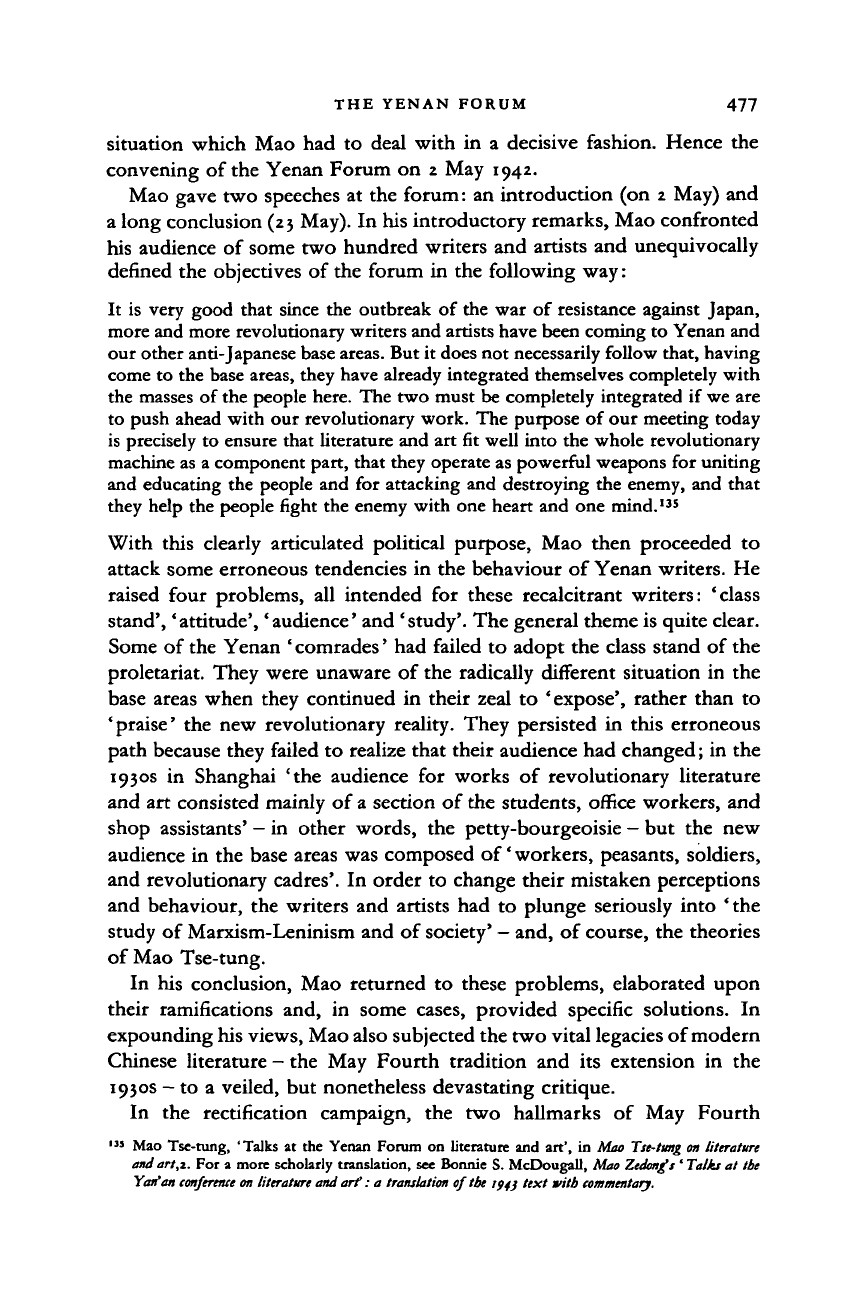
THE YENAN FORUM 477
situation which Mao had to deal with in a decisive fashion. Hence the
convening of the Yenan Forum on 2 May 1942.
Mao gave two speeches at the forum: an introduction (on 2 May) and
a long conclusion (23 May). In his introductory remarks, Mao confronted
his audience of some two hundred writers and artists and unequivocally
defined the objectives of the forum in the following way:
It is very good that since the outbreak of the war of resistance against Japan,
more and more revolutionary writers and artists have been coming to Yenan and
our other anti-Japanese base
areas.
But it does not necessarily follow that, having
come to the base areas, they have already integrated themselves completely with
the masses of
the
people here. The two must be completely integrated if
we
are
to push ahead with our revolutionary work. The purpose of our meeting today
is precisely to ensure that literature and art fit well into the whole revolutionary
machine as a component part, that they operate as powerful weapons for uniting
and educating the people and for attacking and destroying the enemy, and that
they help the people fight the enemy with one heart and one mind.
135
With this clearly articulated political purpose, Mao then proceeded to
attack some erroneous tendencies in the behaviour of Yenan writers. He
raised four problems, all intended for these recalcitrant writers: 'class
stand',' attitude',' audience' and '
study'.
The general theme is quite clear.
Some of the Yenan
'
comrades' had failed to adopt the class stand of the
proletariat. They were unaware of the radically different situation in the
base areas when they continued in their zeal to 'expose', rather than to
'praise' the new revolutionary reality. They persisted in this erroneous
path because they failed to realize that their audience had changed; in the
1930s in Shanghai 'the audience for works of revolutionary literature
and art consisted mainly of a section of the students, office workers, and
shop assistants' - in other words, the petty-bourgeoisie - but the new
audience in the base areas was composed of'
workers,
peasants, soldiers,
and revolutionary cadres'. In order to change their mistaken perceptions
and behaviour, the writers and artists had to plunge seriously into 'the
study of Marxism-Leninism and of society' - and, of course, the theories
of Mao Tse-tung.
In his conclusion, Mao returned to these problems, elaborated upon
their ramifications and, in some cases, provided specific solutions. In
expounding his views, Mao also subjected the two vital legacies of modern
Chinese literature - the May Fourth tradition and its extension in the
1930s - to a veiled, but nonetheless devastating critique.
In the rectification campaign, the two hallmarks of May Fourth
155
Mao Tse-tung, 'Talks at the Yenan Forum on literature and art', in Mao Tse-tung on literature
and art,i. For a more scholarly translation, see Bonnie S. McDougall, Mao Zedongs ' Talks at the
Yatfan
conference
on literature and art': a translation of the 194) text with commentary.
Cambridge Histories Online © Cambridge University Press, 2008
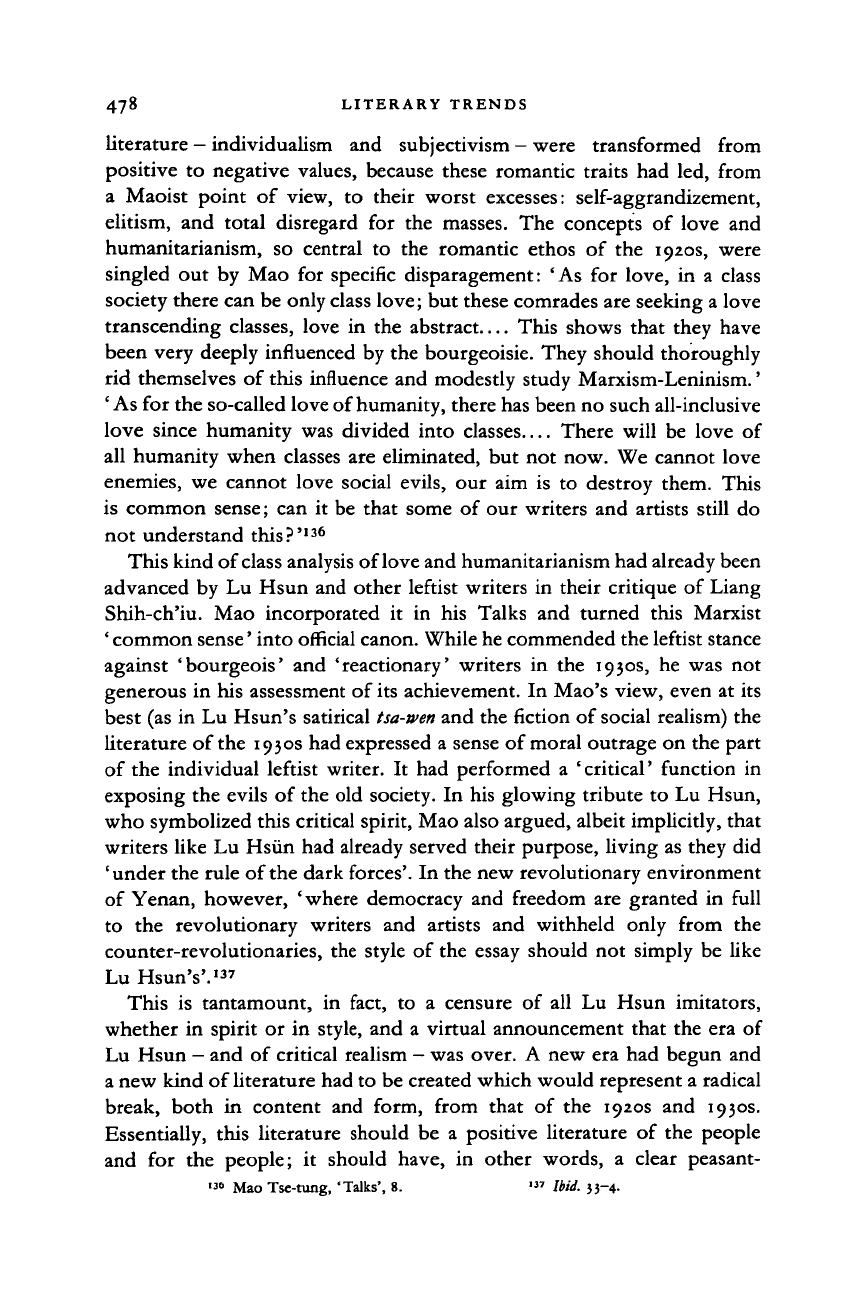
478 LITERARY TRENDS
literature
-
individualism
and
subjectivism
-
were transformed from
positive
to
negative values, because these romantic traits
had led,
from
a Maoist point
of
view,
to
their worst excesses: self-aggrandizement,
elitism,
and
total disregard
for the
masses.
The
concepts
of
love
and
humanitarianism,
so
central
to the
romantic ethos
of the
1920s, were
singled
out by Mao for
specific disparagement:
'As for
love,
in a
class
society there can be only class love; but these comrades are seeking a love
transcending classes, love
in the
abstract This shows that they have
been very deeply influenced
by
the bourgeoisie. They should thoroughly
rid themselves
of
this influence
and
modestly study Marxism-Leninism.'
'As
for
the so-called love of humanity, there has been no such all-inclusive
love since humanity
was
divided into classes There will
be
love
of
all humanity when classes
are
eliminated,
but not
now.
We
cannot love
enemies,
we
cannot love social evils,
our aim is to
destroy them. This
is common sense;
can it be
that some
of our
writers
and
artists still
do
not understand this?'
136
This kind of class analysis of love and humanitarianism had already been
advanced
by Lu
Hsun
and
other leftist writers
in
their critique
of
Liang
Shih-ch'iu.
Mao
incorporated
it in his
Talks
and
turned this Marxist
' common sense' into official canon. While he commended the leftist stance
against 'bourgeois'
and
'reactionary' writers
in the
1930s,
he was not
generous
in
his assessment
of
its achievement.
In
Mao's view, even
at its
best (as
in Lu
Hsun's satirical
tsa-wen
and
the
fiction
of
social realism)
the
literature
of
the 1930s had expressed
a
sense
of
moral outrage
on
the part
of the individual leftist writer.
It had
performed
a
' critical' function
in
exposing
the
evils
of
the
old
society.
In his
glowing tribute
to Lu
Hsun,
who symbolized this critical spirit, Mao also argued, albeit implicitly, that
writers like
Lu
Hsiin
had
already served their purpose, living
as
they
did
' under the rule
of
the dark forces'.
In
the new revolutionary environment
of Yenan, however, ' where democracy
and
freedom
are
granted
in
full
to
the
revolutionary writers
and
artists
and
withheld only from
the
counter-revolutionaries,
the
style
of
the essay should
not
simply
be
like
Lu Hsun's'.
137
This
is
tantamount,
in
fact,
to a
censure
of all Lu
Hsun imitators,
whether
in
spirit
or in
style,
and a
virtual announcement that
the era of
Lu Hsun
-
and
of
critical realism
-
was over.
A
new
era had
begun
and
a new kind
of
literature had to be created which would represent a radical
break, both
in
content
and
form, from that
of the
1920s
and
1930s.
Essentially, this literature should
be a
positive literature
of the
people
and
for the
people;
it
should have,
in
other words,
a
clear peasant-
136
Mao Tse-tung, 'Talks',
8. '«
Ibid.
33-4.
Cambridge Histories Online © Cambridge University Press, 2008
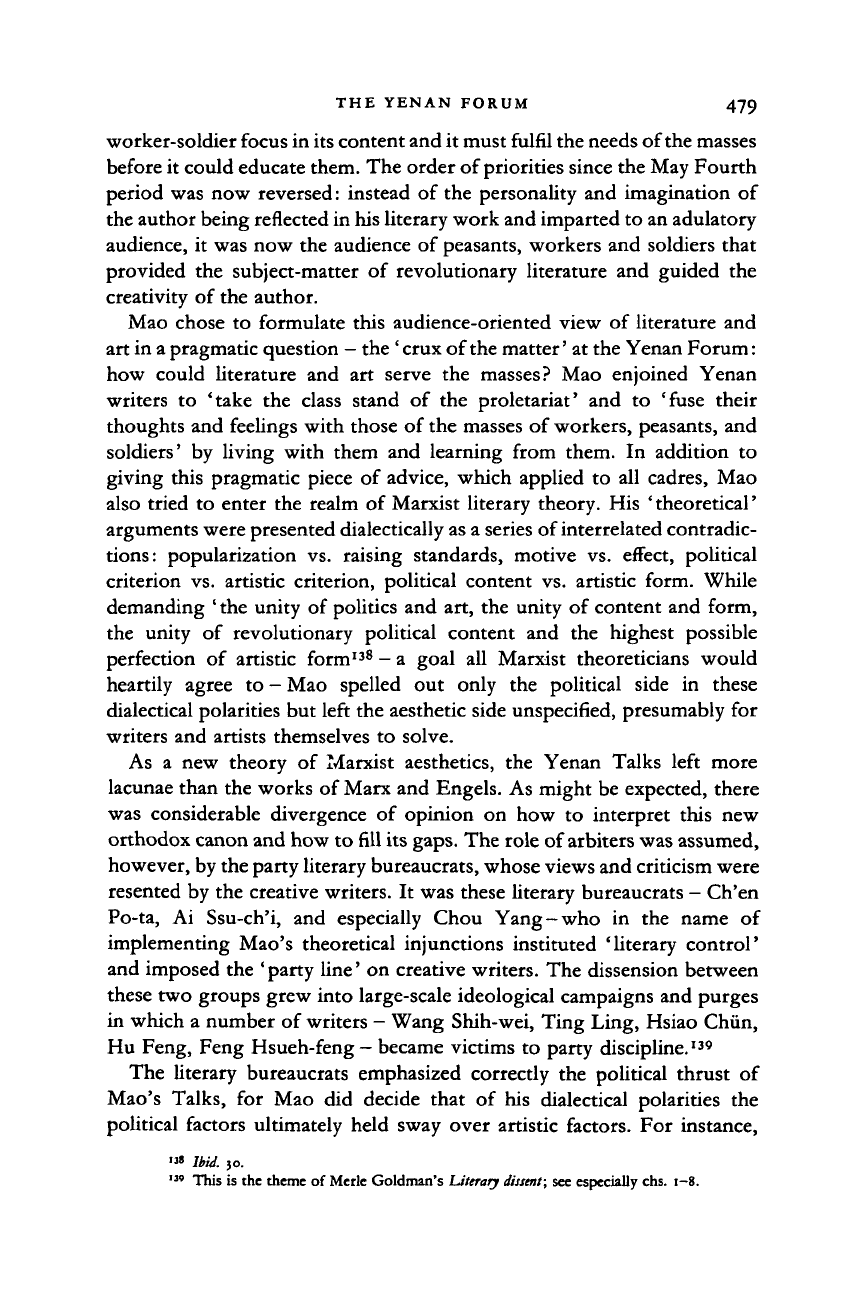
THE YENAN FORUM 479
worker-soldier focus in its content and it must fulfil the needs of the masses
before it could educate them. The order of priorities since the May Fourth
period was now reversed: instead of the personality and imagination of
the author being reflected in his literary work and imparted to an adulatory
audience, it was now the audience of peasants, workers and soldiers that
provided the subject-matter of revolutionary literature and guided the
creativity of the author.
Mao chose to formulate this audience-oriented view of literature and
art in a pragmatic question - the ' crux of the matter' at the Yenan Forum:
how could literature and art serve the masses? Mao enjoined Yenan
writers to 'take the class stand of the proletariat' and to 'fuse their
thoughts and feelings with those of the masses of workers, peasants, and
soldiers' by living with them and learning from them. In addition to
giving this pragmatic piece of advice, which applied to all cadres, Mao
also tried to enter the realm of Marxist literary theory. His ' theoretical'
arguments were presented dialectically as a series of interrelated contradic-
tions:
populari2ation vs. raising standards, motive vs. effect, political
criterion vs. artistic criterion, political content vs. artistic form. While
demanding ' the unity of politics and art, the unity of content and form,
the unity of revolutionary political content and the highest possible
perfection of artistic form
138
- a goal all Marxist theoreticians would
heartily agree to - Mao spelled out only the political side in these
dialectical polarities but left the aesthetic side unspecified, presumably for
writers and artists themselves to solve.
As a new theory of Marxist aesthetics, the Yenan Talks left more
lacunae than the works of Marx and Engels. As might be expected, there
was considerable divergence of opinion on how to interpret this new
orthodox canon and how to fill its gaps. The role of arbiters was assumed,
however, by the party literary bureaucrats, whose views and criticism were
resented by the creative writers. It was these literary bureaucrats - Ch'en
Po-ta, Ai Ssu-ch'i, and especially Chou Yang-who in the name of
implementing Mao's theoretical injunctions instituted 'literary control'
and imposed the
'
party line' on creative writers. The dissension between
these two groups grew into large-scale ideological campaigns and purges
in which a number of writers - Wang Shih-wei, Ting Ling, Hsiao Chun,
Hu Feng, Feng Hsueh-feng- became victims to party discipline.
139
The literary bureaucrats emphasized correctly the political thrust of
Mao's Talks, for Mao did decide that of his dialectical polarities the
political factors ultimately held sway over artistic factors. For instance,
118
Ibid.
30.
135
This is the theme of Merle Goldman's Uterarj dissent; see especially chs. 1-8.
Cambridge Histories Online © Cambridge University Press, 2008
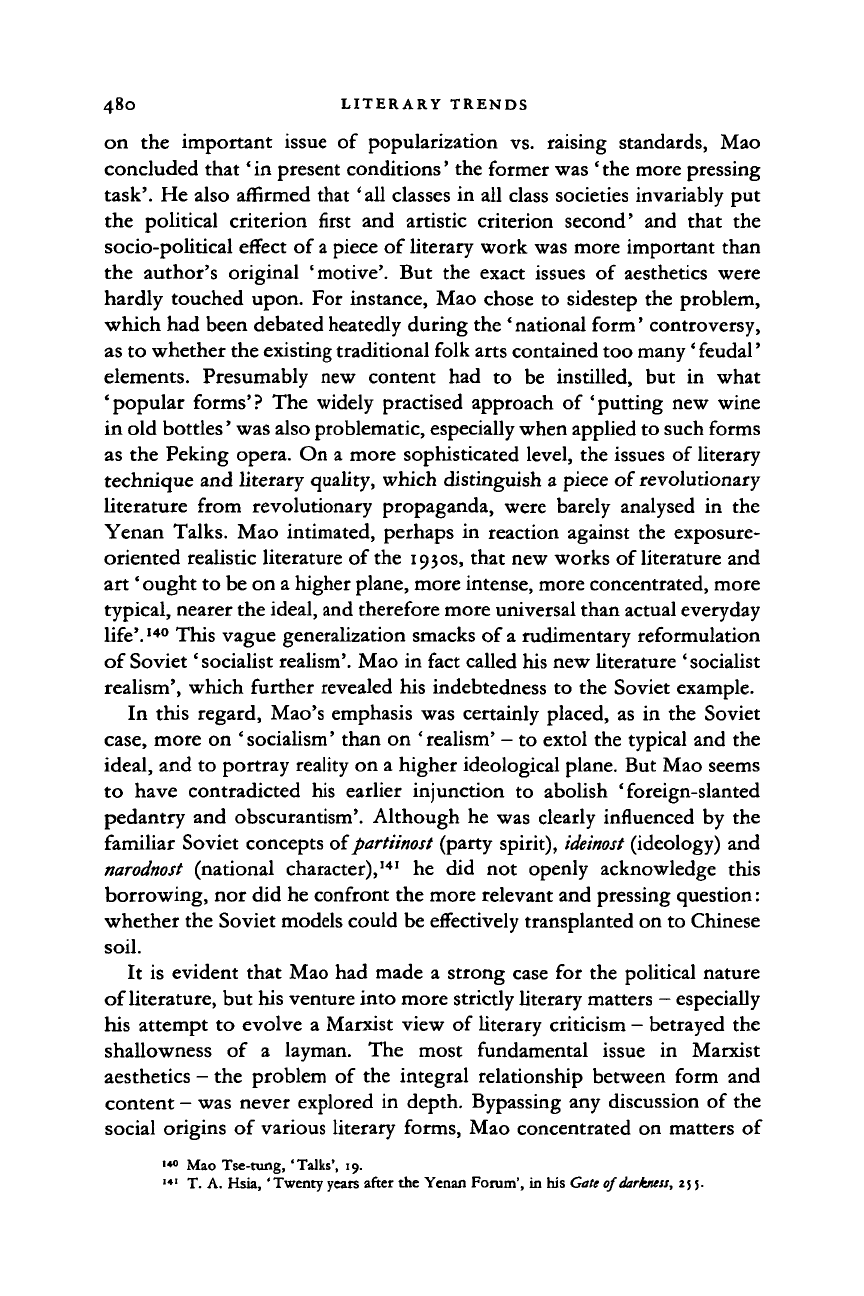
480 LITERARY TRENDS
on
the
important issue
of
popularization
vs.
raising standards,
Mao
concluded that' in present conditions' the former was '
the
more pressing
task'.
He
also affirmed that
'all
classes
in all
class societies invariably
put
the political criterion first
and
artistic criterion second'
and
that
the
socio-political effect
of
a
piece
of
literary work was more important than
the author's original 'motive'.
But the
exact issues
of
aesthetics were
hardly touched upon.
For
instance, Mao chose
to
sidestep
the
problem,
which had been debated heatedly during the ' national form' controversy,
as
to
whether the existing traditional folk arts contained too many' feudal'
elements. Presumably
new
content
had to be
instilled,
but in
what
'popular forms'?
The
widely practised approach
of
'putting
new
wine
in old bottles' was also problematic, especially when applied to such forms
as
the
Peking opera.
On a
more sophisticated level,
the
issues
of
literary
technique and literary quality, which distinguish
a
piece
of
revolutionary
literature from revolutionary propaganda, were barely analysed
in the
Yenan Talks.
Mao
intimated, perhaps
in
reaction against
the
exposure-
oriented realistic literature
of
the 1930s, that new works
of
literature
and
art' ought
to
be on a higher plane, more intense, more concentrated, more
typical, nearer the ideal, and therefore more universal than actual everyday
life'.
140
This vague generalization smacks
of
a rudimentary reformulation
of Soviet 'socialist realism'. Mao
in
fact called his new literature 'socialist
realism', which further revealed
his
indebtedness
to the
Soviet example.
In this regard, Mao's emphasis
was
certainly placed,
as in the
Soviet
case,
more
on
'socialism' than
on
'realism'
- to
extol
the
typical
and the
ideal, and
to
portray reality
on
a higher ideological plane. But Mao seems
to have contradicted
his
earlier injunction
to
abolish 'foreign-slanted
pedantry
and
obscurantism'. Although
he was
clearly influenced
by the
familiar Soviet concepts oipartiinost (party spirit),
ideinost
(ideology)
and
narodnost
(national character),
141
he did not
openly acknowledge this
borrowing,
nor
did
he
confront the more relevant and pressing question:
whether the Soviet models could be effectively transplanted on
to
Chinese
soil.
It
is
evident that Mao
had
made
a
strong case
for the
political nature
of literature, but his venture into more strictly literary matters
-
especially
his attempt
to
evolve
a
Marxist view
of
literary criticism
-
betrayed
the
shallowness
of a
layman.
The
most fundamental issue
in
Marxist
aesthetics
-
the problem
of the
integral relationship between form
and
content
-
was never explored
in
depth. Bypassing
any
discussion
of the
social origins
of
various literary forms, Mao concentrated
on
matters
of
•«° Mao Tse-tung, 'Talks',
19.
141
T. A.
Hsia, 'Twenty years after the Yenan Forum',
in
his Gate of darkness, 255.
Cambridge Histories Online © Cambridge University Press, 2008
